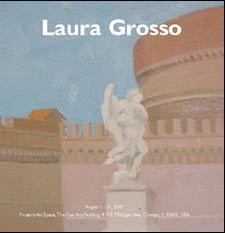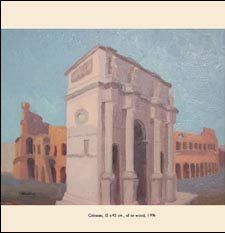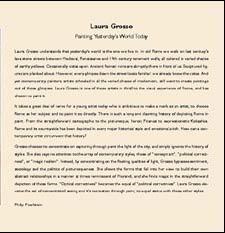


| Laura Grosso Painting Yesterday's World Today | ||||
 | ||||
 |
 |
 |
||
 |
||||
 | ||||
 | ||||
 | ||||
 |
 |
 |
||
 |
||||
 | ||||
 | ||||
 | ||||
|
Catalog Statement
Laura Grosso understands that yesterday's world is the one we live in. In old Rome we walk on last century's lava stone streets between Medieval, Renaissance and 19th century tenement walls, all colored in varied shades of earthy yellows. Occasionally vistas open. Ancient Roman ruins are abruptly there in front of us. Sculptured figures are planked about. However, every glimpse down the street looks familiar: we already know the vistas. And yet contemporary painters, artists schooled in all the varied phases of modernism, still want to create paintings out of those glimpses. Laura Grosso is one of those artists in thrall to the visual experience of Rome, and has chosen to paint it. It takes a great deal of nerve for a young artist today who is ambitious to make a mark as an artist, to choose Rome as her subject and to paint it so directly. There is such a long and daunting history of depicting Rome in paint. From the straightforward cartographic to the picturesque; heroic Piranesi to expressionistic Kokashka. Rome and its countryside has been depicted in every major historical style and emotional pitch. How can a contemporary artist circumvent that history? Grosso chooses to concentrate on capturing through paint the light of the city, and simply ignores the history of styles. She also pays no attention to the array of contemporary styles, those of "concept art", "political correctness", or "magic realism". Instead, by concentrating on the fleeting qualities of light, Grosso bypasses sentiment, sociology and the politics of picturesqueness. She allows the forms that fall into her view to build their own abstract relationships in a manner at times reminiscent of Morandi, and she finds magic in the straightforward depiction of those forms. "Optical correctness" becomes the equal of "political correctness". Laura Grosso elevates the act of concentrated seeing and it's recreation through paint, to equal status with those other styles. Philip Pearlstein |
||||
 | ||||
 | ||||
 | ||||
| View the Work | ||||
 | ||||


